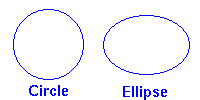

When used in attributing
a work of art, "the
circle of" is a group of artists who shared with the artist
named the style of the work, and
implies a shared geographic origin and close dates for that group.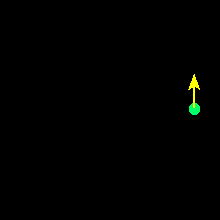
When the distance from the center to the outside of a circle is its radius (half its width), and its width is its diameter, the circumference (or perimeter) of a circle equals two times radius times pi (3.14159), or diameter times pi. The area of a circle equals pi times radius squared, or pi times diameter squared divided by 4, or 0.78539 times diameter squared.
A painting within a circle may be called a tondo in Western tradition, and a mandala in Eastern tradition. Each of these are likely to employ radial balance.
Examples of works in which this shape is important:

England, Salisbury Plain, Stonehenge, c. 2,500-1,500 BCE, stone, 162 inches high, a Stone Age monumental stone temple / observatory located 330 feet above sea level on the chalk downland of Salisbury Plain, about 80 miles west of London near the town of Amesbury. Also see circle, dolmen, megalith, menhir, and monolith.

Raphael (Raffaello Sanzio) (Italian, 1483-1520),
Madonna and Child (Madonna Conestabile),
1502/3, tempera on canvas
(transferred from panel), 7 x 7
inches (17.5 x 18 cm), State Hermitage Museum, St. Petersburg,
Russia. See tondo.

René Jules Lalique (French, 1860-1945),
Necklace, c. 1895-1905, gold, enamel,
Australian opal, Siberian amethysts; overall diameter 9 1/2 inches
(24.1 cm); 9 large pendants:
2 3/4 x 2 1/4 inches (7 x 5.7 cm), 9 small pendants: 1 3/8 x
1 1/4 inches (3.5 x 3.2 cm), Metropolitan Museum of Art, NY.
See Art Nouveau
and jewelry.

Designed by Frank Lloyd Wright (American,
1867-1959), manufactured
by F. Schumacher and Company, New York, Length of Printed Fabric, 1955, silk,
printed, Fortisan (?), 88 x 49 3/4 inches (223.5 x 126.4 cm),
Metropolitan Museum of Art, NY. See architect, architecture, and textile.

Henri Matisse (French, 1869-1954), Dance, 1910, oil
on canvas, 102 x 154 inches
(260 x 391 cm), Hermitage Museum, St. Petersburg, Russia. See
dance and nude.

František Kupka (Czech, 1871-1957),Study from Mechanistic Series, 1923-1926, gouache and pencil on paper, 28 x 28.2 cm, Tehran Museum of Contemporary Art, Iran. See Orphism.

Robert Delaunay (French, 1885-1941), Disks, 1930-33, oil on canvas, 88.3 x 124.5 cm, Museum of Modern Art, NY. See Orphism.

Sven Wingquist, designer, manufacturer: SKF
Industries, Inc., USA, Self-Aligning Ball Bearing, 1929, chrome-plated
steel, 1 3/4
x 8 1/2 inches (4.4 x 21.6 cm) diameter,
Museum of Modern Art, NY. MOMA's site says, "Good design
was considered by modernists as essential to the elevation of
society, and in 1934, this ball bearing was among the first works
to enter The Museum of Modern Art's design collection."
See design
and technology.
Jasper Johns (American, 1930-), Target with Four Faces, 1955, assemblage: encaustic and collage on canvas with objects, 26 x 26 inches. The circles in the target are "concentric" — meaning they all have the same point as their center. See Pop Art.
![]()
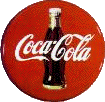
Coca Cola advertising
sign, 20th century, enamel on steel. See icon
and logo.

Sir Eduardo Paolozzi (Scottish, 1924-2005), from "Moonstrips Empire News", [no
title], 1967, screenprint
on paper, image: 38.0 x 25.5 cm,
Tate Gallery, London. This is a set of patterns made entirely
with a motif of circles.

China, Mao is the Red Sun, "Respectfully wish a
long life without end to the reddest, reddest sun in our hearts:
Chairman Mao," from the People's
Republic of China's period known as the Cultural Revolution,
1966-1976, poster,
Burke Museum, U of WA, Seattle.
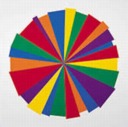
Sol LeWitt (American, 1928-), Untitled,
2001, linoleum cut, 30
x 30 inches, edition of
100. See conceptual art and
Minimalism.
Michael Todd (American, 1935-), Daimaru XV, 1981, lacquered steel, 137 1/2 x 131 1/4 x 40 inches, Sheldon Memorial Art Gallery and Sculpture Garden, U of Nebraska, Lincoln. "Daimaru" is a Japanese word that means "big circle."

Robert Smithson (American, 1938-1973), Broken Circle, Emmen, Holland, 1971,
green water, white and yellow sand flats, diameter 140 feet,
canal approximately 12 feet wide, depth of the quarry lake 10
to 15 feet. See earth
art.

Richard Long (English, 1945-), A Hundred Mile Walk, 1971-2, pencil,
map, printed
text, photographs and labels on board, 21.6
x 48.3 cm, Tate Gallery, London. All
of Long's work results from solitary walks he has undertaken
in different parts of the world. This work documents
the circular route he took on a walk made in December and January
of 1971-2, by means of a map showing his location, a photograph
of part of the landscape passed through and phrases recording
his thoughts and reactions. See earth art and line.

Richard Long (English, 1945-), Small White Pebble Circles, 1987, marble pebbles,
4.0 x 200.0 x 200.0 cm, Tate Gallery, London. This is a concentric
arrangement on a floor
of rocks Long collected while walking.

Richard Long, South Bank Circle, 1991, delabole slate, 10.0 x 199.7 x 199.7
cm, Tate Gallery, London.
Michele Oka Doner (American, contemporary), Ice Ring, 1989, cast bronze, 3 / 3, 18 x 120 x 120 inches, Grounds For Sculpture, NJ.
![]()
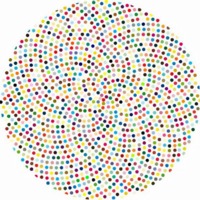
Damien Hirst (British, 1965-), Valium, 2000.
Also see aperture, arc, cone, cylinder, ellipse, fish-eye lens, hyperbola, kaleidoscope, lens, oblong, oval, ovoid, parabola, protractor, regular, sphere, tangent, and teleidoscope.
https://inform.quest/_art
Copyright © 1996-![]()